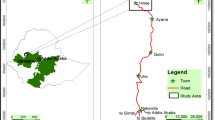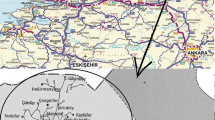Abstract
The Pakistani Gilgit-Baltistan are recognised as being one of the most beautiful and interesting places in the world due to the presence of the longest glaciers and the highest reliefs. This area remained remote and inaccessible before 1965, after which began the construction of the first roads (Karakoram Highway—KKH). In 1992, the Pakistani Government delegated the responsibility for initiating a preliminary survey to outline the borders of the Central Karakoram National Park (CKNP) which allowed a preliminary outline of the borders (about 3000 km2) where the major mountain massifs (as Mt. K2), watersheds, and glaciers were included. Since then, several proposals followed. With the aim of preserving this natural beauty for future generations as well as providing the CKNP of a Management Plan, a 5-year multidisciplinary project called SEED (Social, Economic, Environmental Development) started. One of the project’s objectives was the analysis of the landslide geohazards aiming at the implementation of a landslide inventory and the realization of a susceptibility map. The Arandu village and its surroundings, which is part of Shigar valley, where the Chogolungma glacier is, was chosen as pilot area. During the summer survey had in 2012, part of the landslide-prone areas, previously identified through DEM analysis (derived from ASTER and Remote Sensing (RS) images) and GIS techniques were identified validating the obtained maps. The Analytical Hierarchy Process (AHP) was used to extract the factor weights in a pairwise comparison matrix. Frequency ratio (FR) method was adopted to drive each class weight. The Weighted linear combination was used in the end to determine the landslide susceptibility index value (LSI).
Access this chapter
Tax calculation will be finalised at checkout
Purchases are for personal use only
Similar content being viewed by others
References
Abrams M (2000) The advanced spaceborne thermal emission and reflection radiometer (ASTER): data products for the high spatial resolution imager on NASA’s Terra platform. Int J Remote Sens 21:847–859
Ahmed M, Rogers DJ (2014) First-approximation landslide inventory maps for Northern Pakistan, using ASTER DEM data and geomorphic indicators. Environ Eng Geosci 20:67–83
Ahmed M, Rogers DJ, Ismail EH (2014) A regional level preliminary landslide susceptibility study of the upper Indus river basin. Euro J Remote Sens 47:343–373
Ansari ZR, Rao LAL, Sharan S (2012) Comparative study of terrain elements from different DEMs. Int J Remote Sens GIS 1:57–76
Ayalew L, Yamagishi H, Ugawa N (2004) Landslide susceptibility mapping using GIS-based weighted linear combination, the case in Tsugawa area of Agano River, Niigata prefecture, Japan. Landslides. 1:73–81
Bajracharya B, Bajracharya SR, (2008) Landslide mapping of the everest region using high-resolution satellite images and 3D visualization. Mountain GIS conference, http://www.mtnforum.org/sites/default/files/pub/landslide.pdf
Basharat M, Rohn J, Baig MS, Khan MR (2014) Spatial distribution analysis of mass movements triggered by the 2005 Kashmir earthquake in the Northeast Himalayas of Pakistan. Geomorphology 206:203–214
Calligaris C, Poretti G, Tariq S, Melis MT (2013) First steps towards a landslide inventory map of the Central Karakoram National Park. Euro J Remote Sens 46:272–287
Chang K, Tsai B (1991) The effect of DEM resolution on slope and aspect mapping. Cartogr Geogr Information Syst 18(1):69–77
Chacon J, Irigaray C, Fernandez T, El Hamdouni R (2006) Engineering geology maps: landslides and geographical information systems. Bull Eng Geol Environ 65:341–411
Chau KT, Sze YL, Fung MK, Wong WY, Fong EL, Chan LCP (2004) Landslide hazard analysis for Hong Kong using landslide inventory and GIS. Comput Geosci 30(4):429–443
Choi J, Oh H, Lee HJ, Lee C, Lee S (2012) Combining landslide susceptibility maps obtained from frequency ratio, logistic regression, and artificial neural network models using ASTER images and GIS. Eng Geol 124:12–23
Dahal RK, Hasegawa S, Nonomura A, Yamanaka M, Masuda T, Nishino K (2007) GIS-based weights-of-evidence modeling of rainfall-induced landslides in small catchments for landslide susceptibility mapping. Environ Geol 54:311–324
Davis J (1986) Statistics and data analysis in geology. John Wiley & Sons, New York, p 646
Dhakal AS, Amada T, Aniya M (2000) Landslide hazard mapping and its evaluation using GIS: an investigation of sampling schemes for a grid-cell based quantitative method. Photogram Eng Remote Sens 66(8):981–989
Fell R, Corominas J, Bonnard C, Cascini L, Leroi E, Savage W (2008) Guidelines for landslide susceptibility, hazard and risk zoning for land use-planning. Eng Geol 102:99–111
Ferrari E (2014) Methodological issues in implementing a sustainable forest management plan in remote mountain areas—the Karakorum (Pakistan). PhD Thesis, AGRIPOLIS, Padova University, Padova, 28 Jan 2014
Fourniadis IG, Liu JG, Mason PJ (2007) Landslide hazard assessment in the Three Gorges area, China, using ASTER imagery: Wushan-Badong. Geomorphology 84:126–144
Gardner JS, Saczuk E (2004) System for hazard identification in high mountain areas: an example from the Kullu District, Western Himalaya. J Mount Sci 1(2):115–127
Gokceoglu C (2012) Discussion on “combining landslide susceptibility maps obtained from frequency ratio, logistic regression, and artificial neural network models using ASTER images and GIS” by Choi et al. (2012), Engineering geology, vol 124, pp 12–23. Engineering geology, vol 104, Issue 2, pp 129–130. ISSN: 0013-7952
Gullà G, Antronico L, Iaquinta P, Terranova O (2008) Susceptibility and triggering scenarios at regional scale for shallow landslides. Geomorphology 99:39–58
Guzzetti F, Mondini AC, Cardinali M, Fiorucci F, Santangelo M, Chang KT (2012) Landslide inventory maps: new tools for an old problem. Earth Sci Rev 112:42–66
Intarawichian N, Dasanada S (2010) Analytical Hierarchy Process for landslide susceptibility mapping in lower Mae Chaem watershed, northern Thailand. Suranaree J Sci Technol 17(3):227–292
Kamp U, Bolch T, Olsenholler J (2003) DEM generation from ASTER satellite data for geomorphometric analysis of cerrosillajhuay, Chile/Bolivia. In: Proceedings of the ASPRS 2003 annual conference, Anchorage, Alaska, USA, p 9
Kamp U, Growley BJ, Khattak GA, Owen LA (2008) GIS-based landslide susceptibility mapping for the 2005 Kashmir earthquake region. Geomorphology 101:631–642
Kanwal S, Atif S, Shafiq M (2016) GIS based landslide susceptibility mapping of northern areas of Pakistan, a case study of Shigar and Shyok Basins. Geomatics Nat Haz Risk 1–19. doi:10.1080/19475705.2016.1220023
Kawabata D, Bandibas J (2009) Landslide susceptibility mapping using geological data, a DEM from ASTER images and an artificial neural network (ANN). Geomorphology 113(1–2):97–109
Komac M (2006) A landslide susceptibility model using the Analytical Hierarchy Process method and multivariate statistics in perialpine Slovenia. Geomorphology 74:17–28
Le Fort P, Arnaud P, (2002) Geological map of Hunza to Baltistan Karakoram—Koisthan—Ladakh—Himalaya North Pakistan (1:150,000 scale). Geologica 6(1):1–199. ISSN: 1025-2541
Mari F, Gallo M, Vuillermoz E, Milanesi D, Decè L, Buraschi E, Hassan R (2014) Research baselines for CKNP Management Plan. Ev-K2-CNR, 2014; p 508, http://www.cknp.org/cms/wp-content/uploads/2014/12/BASELINE-CKNP-Oct-2014.pdf
Milevski I, Markoski B, Gorin S, Jovanovski M (2009) Application of remote sensing and GIS in detection of potential landslide areas. In: Proceedings of the scientific symposium geography and sustainable development, Ohrid, Republic of Macedonia. 2009; pp 453–463
Moradi M, Bazyar MH, Mohammadi Z, (2012) GIS-based landslide susceptibility mapping by AHP method, a case study, Dena city, Iran. J Basic Appl Sci Res 2(7):6715–6723. ISSN 2090-4304
Nefeslioglu HA, Gokceoglu C, Sonmez H (2008) An assessment on the use of logistic regression and artificial neural networks with different sampling strategies for the preparation of landslide susceptibility maps. Eng Geol 97(3–4):171–191
Ohlmacher GC (2007) Plan curvature and landslide probability in regions dominated by earth flows and earth slides. Eng Geol 91:117–134
Othman NA, Naim WM, Noraini S (2012) GIS based multi-criteria decision making for landslide hazard zonation. Proc Soc Behav Sci 35:595–602
Park S, Choi C, Kim B, Kim J (2013) Landslide susceptibility mapping using frequency ratio, analytic hierarchy process, logistic regression, and artificial neural network methods at the Inje area, Korea. Environ Earth Sci 68:1443–1464. doi:10.1007/s12665-012-1842-5
Pêcher A, Le Fort P (1999) Late Miocene evolution of the Karakorum-Nanga Parbat contact zone (northern Pakistan). Geol Soc Am 328:145–158
Peduzzi P (2010) Landslides and vegetation cover in the 2005 North Pakistan earthquake: a GIS and statistical quantitative approach. Nat Haz Earth Syst Sci 10:623–640
Phukon P, Chetia D, Das P, (2012) Landslide susceptibility assessment in the Guwahati City, Assam using analytic hierarchy process (AHP) and geographic information system (GIS). Int J Comput Appl Eng Sci 2(1):1–6. ISSN: 2231-4946
Ruff M, Czurda K (2008) Landslide susceptibility analysis with a heuristic approach in the Eastern Alps (Vorarlberg, Austria). Geomorphology 94:314–324
Saaty TL (1980) The analytic hierarchy process, planning, priority setting, resource allocation. McGraw-Hill, New York
Saha AK, Gupta RP, Sarkar I, Arora MK, Csaplovics E (2005) An approach for GIS-based statistical landslide susceptibility zonation with a case study in the Himalayas. Landslides 2:61–69
Sarkar S, Kanungo DP (2004) An integrated approach for landslide susceptibility mapping using remote sensing and GIS. Photogram Eng Remote Sens 70(5):617–625
Song KY, Oh HJ, Choi J, Park I, Lee C, Lee S (2012) Prediction of landslide using ASTER imagery and data mining models. Adv Space Resol 49:978–993
Spiker EC, Gori PL (2000) National landslide hazards mitigation strategy: a framework for loss reduction. Department of Interior, USGS, Open-file Report 00-450, 2000; p 49
Tarolli P, Arrowsmith JR, Vivoni ER (2009) Understanding earth surface processes from remotely sensed digital terrain models. Geomorphology 113:1–3
Tarolli P, Sofia G, Dalla Fontana G (2012) Geomorphic features extraction from high-resolution topography: landslide crowns and bank erosion. Nat Haz 61:65–83
Toutin T (2008) ASTER DEMs for geomatic and geoscientific applications: a review. Int J Remote Sens 29(7):1855–1875
Van Westen CJ, Castellanos E, Kuriakose SL (2008) Spatial data for landslide susceptibility, hazard and vulnerability assessment: an overview. Eng Geol 102(3–4):121–131
WP/WLI (International Geotechnical Societies’ UNESCO Working Party on World Landslide Inventory) (1994) A suggested method for describing the causes of a landslide. Bull Int Assoc Eng Geol 50:71–74
Yalcin A, Reis S, Aydinoglu AC, Yomralioglu T (2011) A GIS-based comparative study of frequency ratio, analytical hierarchy process, bivariate statistics and logistics regression methods for landslide susceptibility mapping in Trabzon, NE Turkey. CATENA 85:274–287
Acknowledgements
This research was developed within the framework of the SEED (Social Economic and Environmental Development in the CKNP Region, Northern Areas, Pakistan) Project, funded by the Governments of Italy and Pakistan in collaboration with the Ev-K2-CNR Committee and Karakorum International University. A particular acknowledgement goes to Prof. Maria Teresa Melis of Cagliari University for the ASTER datasets management and to Prof. Franco Cucchi of Trieste University for the insightful suggestions. The Authors gratefully acknowledge the anonymous reviewer.
Author information
Authors and Affiliations
Corresponding author
Editor information
Editors and Affiliations
Rights and permissions
Copyright information
© 2017 Springer International Publishing AG
About this paper
Cite this paper
Calligaris, C., Tariq, S., Khan, H., Poretti, G. (2017). Landslide Susceptibility Analysis in Arandu Area Shigar Valley, CKNP (Gilgit-Baltistan- Pakistan). In: Mikos, M., Tiwari, B., Yin, Y., Sassa, K. (eds) Advancing Culture of Living with Landslides. WLF 2017. Springer, Cham. https://doi.org/10.1007/978-3-319-53498-5_103
Download citation
DOI: https://doi.org/10.1007/978-3-319-53498-5_103
Published:
Publisher Name: Springer, Cham
Print ISBN: 978-3-319-53497-8
Online ISBN: 978-3-319-53498-5
eBook Packages: Earth and Environmental ScienceEarth and Environmental Science (R0)




